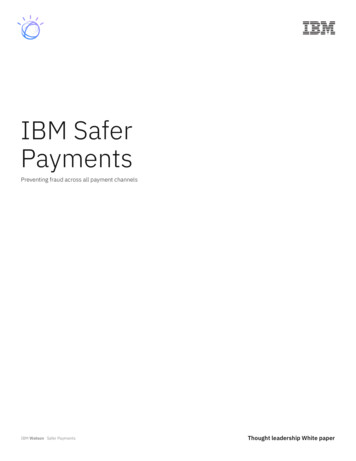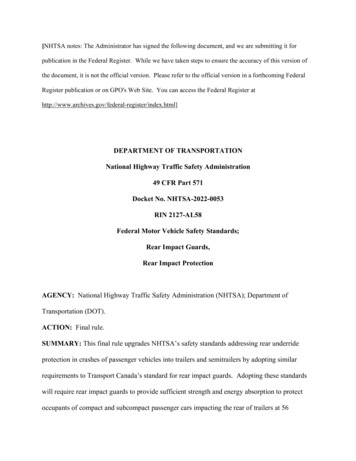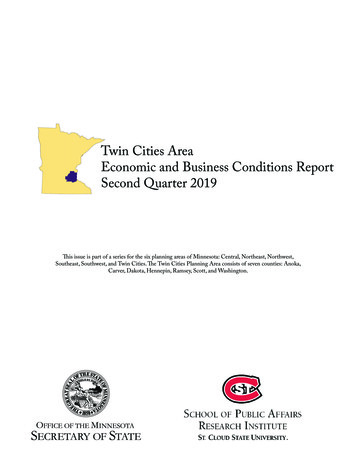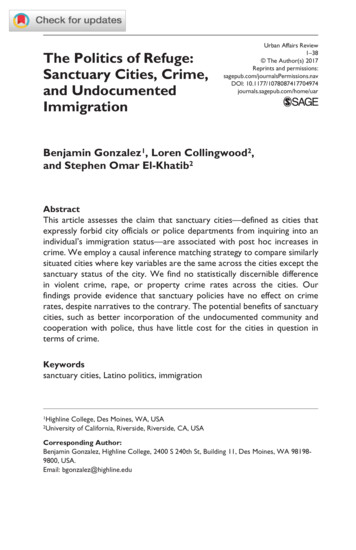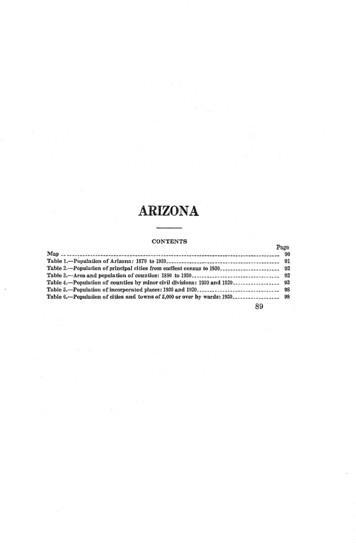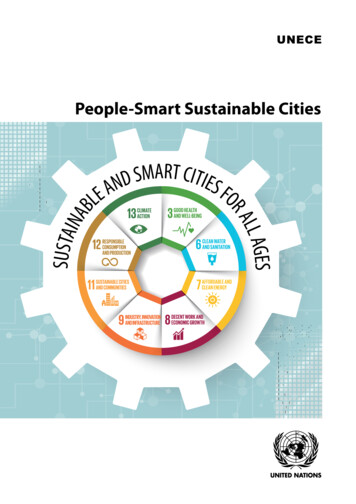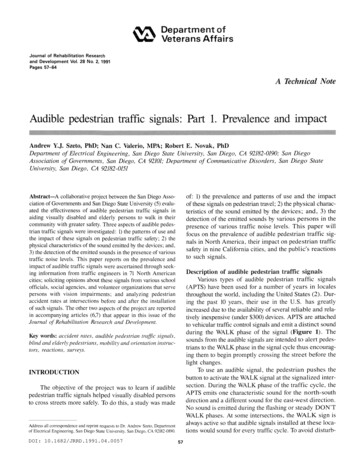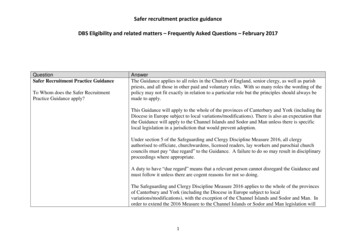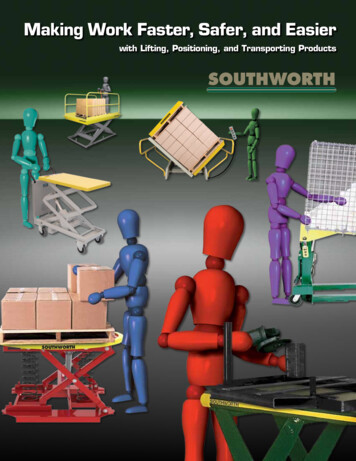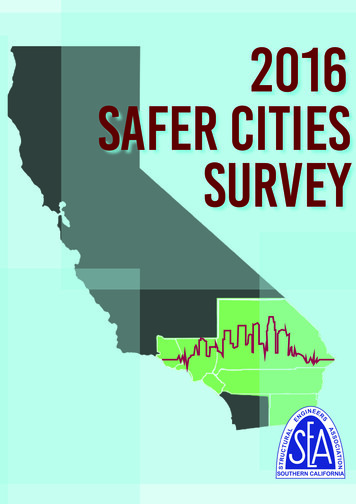
Transcription
2016Safer CitiesSurvey
Loaded withsoft-story retrofitquestions?Well, we have the answers. We are here to provide technical resources andjobsite assistance with the vulnerable buildings associated with the Safer CitiesSurvey. Call (800) 999-5099 or visit strongtie.com for help on finding yourperfect retrofit solution. 2016 Simpson Strong-Tie Company Inc.
safer cities surveyPresented byEvaluating current approaches to retrofitting seismicallyvulnerable buildings in Southern CaliforniaA partnership rThis Safer Cities Survey has been prepared by the Dr. Lucy Jones Center for Science and Society (DLJCSS) for the Structural Engineers Association of Southern California(SEAOSC), and is published as part of our association’s educational program. While the information presented in the document is believed to be correct at the timeof publication, the materials, practices, and understanding of the matters discussed are sometimes subject to differences of opinion and approach, and are constantlyevolving. As such, neither SEAOSC nor its Board, committees, writers, editors, firms, or individuals who have contributed to this survey make any warranty, expressed orimplied, or assume any legal liability or responsibility for the use, application of, and/or reference to opinions, findings, conclusions, or recommendations expressed herein. This survey should not be used or relied upon for any specific application without competent examination and verification of its accuracy, suitability, and applicabilityby qualified professionals. This survey is not intended to amount to minimum standards for any purpose. Users of this survey assume all liability arising from such use.The user is advised to check updates/errata pertaining to this survey, which are posted at www.seaosc.org. Inquiries may be addressed to seaosc@seaosc.org.Structural Engineers Association of Southern California 2016 SEAOSCAll rights reserved.This document or any part thereof may not be reproduced in any form without the written permission of SEAOSC.1
seaosc President's messageDear Southern Californians,We live in an age of unparalleled global interconnectedness and access toinformation with 24/7 news channels and mobile technology with nearconstant social media availability. As a result, we are exposed to majornatural disasters in real time.Even in the fortunate eventwhere the death toll is low,affected communities can losemany buildings which mayhave an extreme detrimentaleconomic impact and requiredecades of recovery time. Thenews exposure to recent eventshas increased the public’sknowledge of natural disaster SEAOSC Past President Michelle Kam-Biron, Dr. Lucy Jones, and SEAOSC President Jeff Ellis.risk and building performanceand has driven public discussions on how we can increase the safety and resilienceof our communities. Thankfully, technology, tools and methodologies to evaluateand communicate natural disaster risk are available. Coupled with continuedadvancement in building performance determination, the public and policymakersare afforded a better understanding of risk and potential solutions and are providedwith a better way to understand and communicate the cost of doing nothing versustaking action.In order to develop an effective strategy to improve the safety and resilience of ourcommunities, it is critical to benchmark building performance policies currently inplace. For Southern California, this benchmarking includes recognizing which buildingtypes are most vulnerable to collapse in earthquakes, and understanding whetheror not there are programs in place to decrease risk and improve recovery time. Inlight of this, the Structural Engineers Association of Southern California (SEAOSC)partnered with the Dr. Lucy Jones Center for Science and Society (DLJCSS) to performa survey of the cities in Southern California with the goal of providing a snapshot ofcurrent strategies to strengthen the built environment in our region.2016 Safer Cities Survey
This Safer Cities Survey is designed to beused as a tool to help identify vulnerablebuilding types, show where we are inaddressing these buildings throughretrofit ordinances, and provide a lens tobetter see where to focus our attentionto reduce our vulnerabilities. Structuralengineers have long recognized the needto strengthen existing buildings, butpolicy changes required to achieve thisrequire input from many stakeholdersand the skill and adeptness of our localleaders to advance common goals. Asthe discussion continues, SEAOSC willupdate the information in this report tomeasure progress, which is something wecan only achieve with the stakeholdersworking together toward a common goalfor safer and more resilient cities.SEAOSC is a one of the oldest structuralengineering associations in the world.We strive to advance the state-of-the-artin structural engineering and to providethe public with safe structures. SEAOSCstands ready to help jurisdictionsdevelop strategies to mitigate riskand increase resilience by decreasingrecovery time. Improved performanceof our community’s and region’s builtenvironment is critically important tosaving lives as well as important toprotecting its economy, character andfabric. One of the first steps in developinga mitigation strategy includes consultingwith practicing professional engineersso they may establish an inventory ofvulnerable buildings within a city, assistin the development of draft retrofitordinances, and provide input toward thecreation of a back-to-business program.SEAOSC can provide an objective, thirdparty review and offer advice on thedeveloped ordinances and programs.In fact, SEAOSC has already providedthis advisory service for jurisdictions inSouthern California at their request.We endeavor to make this Safer CitySurvey a useful tool in understandingwhere we are as a region and in thedevelopment of prioritized strategiesto increase the safety and resilience ofour communities. Southern California isan incredible place to live, full of greatopportunities with a diverse populationand many cultures stretching from thebeach to the mountains and desert. Letus continue to work together to sustainthese opportunities by ensuring ourregion does not get knocked out by thenext natural disaster but is able to rollwith the punches and quickly recover.Yours for a safer and more resilientsouthern California,Jeff EllisPresident, SEAOSC3
The Safer Cities Survey By: DLJCSSSummaryStudies show many types of buildings in Californiabuilt under earlier versions of the building code arenow known to be very vulnerable to earthquakedamage and will be responsible for the majority of deathsin future earthquakes. Ordinances to encourage or mandate the retrofit of these buildings for improved seismicsafety are the main tool available for local jurisdictions toreduce this risk. This Safer Cities Survey report (referredto as Survey in this report) provides an overview of theseismic ordinances that have been enacted or are underconsideration in the jurisdictions of Southern California.2016 Safer Cities Survey
Introduction/BackgroundSouthern California has thehighest risk of earthquakedamage in the United States.Straddling the plate boundary between thePacific Ocean and North American plates,southern California has over a hundred faultscrisscrossing the region with almost 20 millioninhabitants. The combination of many faultsand dense population means that betweenone third and one half of the nation’s estimated 4.5 billion/year seismic losses are expected to occur in the region (Jaiswal et al., 2015).Several scenarios have been created for possible big earthquakes in the region to better understand the most likely causes of major lossand the triggering of regional depression (examples include Jones, 2015; Wein and Rose,2011; Jones et al, 2008; EERI, 2011). The twobiggest factors are the loss of buildings for residential and commercial use and the disruption to basic infrastructure. The deadliest typeof building loss is in the older structures thatdo not meet current building code standardsfor life safety.No building code is retroactive; a building is asstrong as the building code that was in placewhen the building was built. When an earthquake in one location exposes a weaknessin a type of building, the code is changed toprevent further construction of buildings withthat weakness, but it does not make thosebuildings in other locations disappear. Forexample, in Los Angeles, the strongest earthquake shaking has only been experienced inthe northern parts of the San Fernando Val-ley in 1971 and 1994 (Jones, 2015). InSan Bernardino, a city near the intersection of the two most active faultsin southern California where some ofthe strongest shaking is expected, thelast time strong shaking was experienced was in 1899. Most buildings insouthern California have only experienced relatively low levels of shakingand many hidden (and not so hidden)vulnerabilities await discovery in the nextearthquake.The prevalence of the older, seismically vulnerable buildings varies across southern California. Some new communities, incorporatedin the last twenty years, may have no vulnerable buildings at all. Much of Los Angeles County and the central areas of the other countiesmay have very old buildings in their originaldowntown that could be very dangerous in anearthquake, surrounded by other seismicallyvulnerable buildings constructed in the building booms of the 1950s and 1960s.Building codes do have provisions to requireupgrading of the building structure when abuilding undergoes a significant alteration orwhen the use of it changes significantly (e.g.,a warehouse gets converted to office or livingspace). Seismic upgrades can require changesto the fundamental structure of the building.Significantly for a city, many buildings never undergo a change that would trigger anupgrade. Consequently, known vulnerablebuildings exist in many cities, waiting to kill orinjure citizens, pose risks to neighboring buildings, and increase recovery time when a nearby earthquake strikes.5
The main tool available to cities to reduce this risk are ordinances to recommend or mandatestrengthening of buildings through seismic retrofitting. Most retrofit ordinances are at the complete discretion of an individual jurisdiction and have passed when the community members,structural engineers, elected officials and building departments work together because of ashared commitment to safety. This report reviews the different earthquake building vulnerabilities that can be addressed through seismic retrofit ordinances, the approaches being taken incities across southern California and the status of progress.methodologyThe DLJCSS surveyed seismic safety ordinances enacted and under consideration in the 191cities and 6 counties of Southern California that are shown in Figure 1.The primary data was obtained through telephone calls and emails to the Building Officials of each jurisdiction, supplemented with searches of city codes available online anddiscussions with active members of the building code community.DLJCSS asked about retrofit ordinances addressing the mostcommon types of dangerousbuildings as well as businessresumption programs thathave been used in Californiajurisdictions to reduce earthquake losses.Figure 1. Area of California considered in this study.2016 Safer Cities Survey
Types of Vulnerable BuildingsThe three most damaging earthquakes to strikesouthern California, the 1933 Long Beach M6.4,1971 San Fernando M6.7, and 1994 Northridge M6.7earthquakes, each exposed significant weaknesses inexisting buildings and led to changes in the buildingcodes for new structures. For example, following earthquakes, unreinforced masonry buildings were outlawed, concrete construction was required to be moreflexible (ductile), soft-story construction was restricted,requirements for tilt-up construction were strengthened, and welded steel moment frame connections underwent a massive testing program. It is the buildingsbuilt before these earthquakes, and before subsequentchanges to the code, that represent a major risk to thesafety of the occupants. Below are descriptions of eachsignificant type and what is needed to make them safer.7
Unreinforced Masonry (URM)The 1933 Long Beach earthquake was a moderate earthquake, magnitude 6.4 that caused ahigh level of damage because the fault ran through the populated areas of Long Beach wherevulnerable buildings were built in loose, saturated soils. Most of the damage occurred in brickand masonry buildings without any internal steel reinforcement. When the mortar between thebricks and stones lost strength in the shaking, the bricks holding up the roof fell, causing the roofto collapse. Because the bricks and roof are often very heavy, collapse of these buildings is particularly deadly. These risks to life can be significantly reduced with targeted retrofitting.In 1986, the state of Californiapassed the unreinforced masonry (URM) law that requiredall jurisdictions in high seismicactivity areas (identified as Seismic Zone 4 in the Uniform Building Code) to catalog their URMbuildings and develop a programto address the risk but left it toeach jurisdiction to determinewhat form the program wouldtake. Seismic Zones are no longer a part of the building code,which now uses the Nationalwall of the John Muir School, Pacific Avenue, Long Beach, California, downed by theSeismic Hazard Map from the US FrontMarch 11, 1933 earthquake. Photo credit: W.L. Huber, earthquake.usgs.govGeological Survey. Much of thesouthern California region is in what was Seismic Zone 4, with the exception of the eastern partsof Riverside and San Bernardino Counties. Because of the State URM Law, most jurisdictionshave some law enacted.2016 Safer Cities Survey
Wood-Frame BuildingsIn general, properly built, wood-frame buildings, such as the average single-family home, aresome of the safest buildings in California during earthquakes. Wood is light and flexible, bothadmirable characteristics under earthquake shaking. The 1933 earthquake showed that whena building slides off its foundation, it may not kill people, but it can be a complete financial loss.The 1935 Uniform Building Code required that buildings be bolted to their foundation. The 1971earthquake showed this was not enough for buildings with raised foundations and cripple walls.A cripple wall, a wood stud wall between the foundation and the first floor, creates a crawl spaceand is typically made of spaced 2x lumber that can topple like dominoes when pushed sideways in an earthquake. Therefore, since 1976, these buildings are required to be bolted to thefoundation and have wood structural panels to brace the 2x framingwithin the cripple wall.No jurisdiction has imposed mandatory requirements on single-family homes. Some have adoptedvoluntary programs to encourageretrofitting and the California Earthquake Authority (www.earthquakeauthority.com) partners with somejurisdictions to provide funding toencourage improvements.Wood-frame building in Long Beach, California, destroyed by the March 11, 1933 earthquake. Photo credit: earthquake.usgs.gov9
Tilt-Up Concrete BuildingsThese are buildings where concrete wallsand columns are created on site in horizontal position on the building slab andthen tilted up to be tied together andconnected to the roof structure. Manyof these failed in the 1971 earthquakebecause the connections between wallsand roof were not adequate enough.The standards have been improved andpost-1976 tilt ups have performed better. Several jurisdictions adopted programs to upgrade older buildings afterthe 1994 Northridge earthquake.Tilt-up concrete building damaged in the 1994 Northridge earthquake. Photo credit:George Sakkestad.Non-Ductile Reinforced Concrete BuildingsConcrete is a “non-ductile” material,meaning it cracks and breaks duringstrong earthquake shaking if there arenot enough steel reinforcing bars tohold the concrete together. The partialcollapse of the then-recently built OliveView Hospital in the 1971 San Fernando earthquake was shocking and ledto major changes in the 1976 buildingcode requirements for concrete buildings. These buildings were common,representing many of the commercialbuildings built in southern California.Like for tilt-up buildings (which are realPartial collapse of the Olive View Hospital in the 1971 San Fernando earthquake.ly a subset of the non-ductile reinforced Photo credit: NOAA/NGDC, E.V. Leyendecker, U.S. Geological Survey.concrete type), the 1976 code requireda different approach to connecting the walls and roof. The collapse of more of the buildings ofthe older type in the 1994 Northridge earthquake as well as many other earthquakes in otherparts of the world have demonstrated that these are some of the deadliest vulnerable buildingsduring earthquakes (e.g., Otani, 1999). After the 1994 earthquake, the California Seismic SafetyCommission recommended retrofit be required for these buildings (CSSC, 1995).2016 Safer Cities Survey
Soft First-Story BuildingsThe 1989 Loma Prieta earthquake inthe San Francisco Bay area and the1994 Northridge earthquake togetherbrought home the problems presentedby soft first story construction practices.A “soft first-story” building is one wherea big opening in the first floor walls,such as a for carport or retail windows,makes the first story much weaker thanthe stories above. This concentrates theshaking into the first story during theearthquake and makes it more likely tocollapse at the first story endangeringthe inhabitants.Collapse of the Northridge Meadows apartment building in the 1994 Northridgeearthquake. Photo credit: NOAA/NGDC, M. Celebi, U.S. Geological Survey.Because many of the buildings are residential, they represent a particularly critical threat tolives and a major loss to a community after the earthquake. The retrofit is also relatively economical and non-invasive, involving just a strengthening of the first story. This has meant thatseveral jurisdictions have started considering ordinances to address the problem.Pre-1994 Steel Moment Frame BuildingsAfter the failure of the concrete buildingsin the 1971 San Fernando earthquake,many turned to steel as a better buildingmaterial for seismic safety. Because steel is“ductile” (bends rather than cracking whenpushed beyond its strength), it seemed asafer way to build buildings. Even if thestrength of the building is exceeded, itwas thought that the ductility of the steelwould prevent collapse and people couldget out alive. The 1994 Northridge earthquake exposed flaws in this construction.steel frame building in Kobe, Japan where cracks through columns led to colIn some buildings, the welding of beams Alapseof one floor in the 1995 M6.9 earthquake. Photo credit: Chuo Ward.to columns changed the material properties of the steel and cracks formed in the welds. In a bigger earthquake than Northridge whereground shaking will last for a longer duration, engineers now know there is a real risk of collapsein these older, steel moment frame buildings.11
Approaches for MitigationJurisdictions have taken a variety of approaches to increase their community’s earthquake resilience that include retrofitting ordinances thatseek to reduce the risk before the earthquake happens and programsthat will improve the ability of the community to recover. The retrofit ordinances are, in general, specific to the type of building and may be eithermandatory or voluntary. In the Survey results, there are the following possible categories: Mandatory: An enacted ordinance that requires retrofitting Mandatory but incomplete: This is used only for the URM laws thathave been in place for several decades. It is an enacted mandatoryordinance with incomplete enforcement so that less than 50% of thebuildings have been retrofitted or demolished. Voluntary: An ordinance that encourages retrofitting and providestechnical standards without requiring the action. In development: Survey response was that ordinances are being actively developed. In discussion: Survey response was that city personnel are beginningto discuss the options and explore possibilities. Not Applicable: Many jurisdictions have no URMs so there would beno point in having a URM law. The data is available through the StateURM law (State of California, 1986). None: No ordinance in place or in discussion. Unlike for URMs, thereis no data to determine if each jurisdiction has any of the other building types, such as tilt-up concrete or steel moment frame. Severalbuilding officials told us their city is young and they do not believethey have problem buildings. This should be considered when lookingat the data.2016 Safer Cities Survey
Unreinforced Masonry (URM)Because the 1986 California URM law requiringall jurisdictions in the earlier Seismic Zone 4 perthe Uniform Building Code to develop a retrofitprogram, these programs are widespread (seeFigure 2). These buildings were prohibited frombeing constructed after 1935, so 58 jurisdictionssurveyed had no URMs and therefore no needfor a program. The majority of the remaining jurisdictions have programs that mandate retrofitof URMs although not all have been successfulin retrofitting or demolishing all of their URMbuildings. Twelve jurisdictions have mandatoryprograms that achieved less than 50% compliance. Imperial and Los Angeles Counties havethe highest rate of mandatory programs whileSan Bernardino County has the lowest.RESULTSOverall Unreinforced MasonryNot ApplicableMandatoryMandatory (Incomplete)VoluntaryNoneOrange County Unreinforced MasonrySan Bernardino County Unreinforced MasonryVentura County Unreinforced MasonryRiverside County Unreinforced MasonryImperial County Unreinforced MasonryLos Angeles County Unreinforced MasonryFigure 2. Ordinances to address Unreinforced Masonry for all six counties and by county.13
Other Vulnerable Building TypesFor the remaining types of vulnerable buildings (woodframe, tilt-up, non-ductile concrete, pre-1994 steel moment frame, soft first-story), very few jurisdictions areconsidering any action at this time. No jurisdictions in SanBernardino or Riverside Counties have any program to address the other five building types. Imperial County hasone jurisdiction with a mandatory tilt-up concrete retrofit program but no other programs. Six other jurisdictionshave tilt-up concrete retrofit requirements, one in OrangeCounty and five in Los Angeles.The City of Downey is an interesting case. In 1985, theDowney City Council passed a law (amended in 1995) thatall buildings built before 1957 of all types had to be evaluated for their seismic resilience and brought up to code ifthey were found to be deficient. This law addresses manyof the issues discussed here but not completely as all buildings designed prior to the 1971 earthquake are possiblyvulnerable. In the data analysis, it was considered a mandatory code for all building types, but note that the critical1957-1975 period has not been addressed.Overall Tilt-UpOrange CountySan Bernardino CountyVentura CountyImperial CountyLos Angeles CountyThe most common mandatory code other thanthe required action on Unreinforced Masonry isfor concrete tilt-up buildings (see Figure 3).Most of these laws were enacted afterthe 1994 Northridge earthquake.In DevelopmentMandatoryIn DiscussionVoluntaryNoneFigure 3. Ordinances to addresstilt-up concrete buildings for allsix counties and individually bycounty.2016 Safer Cities SurveyRiverside County
The most common interest currently is inretrofitting soft first-story buildings (see Figure 4). Seven of the 191 cities are considering or have taken action, including one cityin Ventura County and six in Los AngelesCounty. Two cities have enacted mandatory programs, two have voluntary programs,and three are in discussion or working ondeveloping a proposed program. In addition, Los Angeles County is working on a voluntary program and, if it is included in thecounty building code, it will apply to its contract cities. Because this is not yet clear, DLJCSS marked the contract cities as being indiscussion.In DevelopmentMandatoryIn DiscussionVoluntaryNoneOverall Soft First-StoryOrange CountySan Bernardino CountyVentura CountyRiverside CountyImperial CountyLos Angeles CountyFigure 4. Ordinances to address softfirst-story construction for all sixcounties and individually by county.15
Overall Non-Ductile ConcreteOrange CountySan Bernardino CountyRiverside CountyImperial CountyVentura CountyLos Angeles CountyIn DevelopmentMandatoryIn DiscussionVoluntaryNoneFigure 5. Ordinances to address non-ductile concrete buildings for all six counties and individually by county.Only two mandatory programs have been enactedfor non-ductile concrete buildings (see Figure 5).Santa Monica enacted a mandatory program afterthe Northridge earthquake but has not achieved significant enforcement and is discussing moving forward with a new law to close that gap. The 2015 lawin Los Angeles is the only recent action and requiresretrofitting within 25 years. Downey’s pre-1957building law shows up here. Long Beach and Burbank have voluntary programs from the 1990s, andWest Hollywood and Beverly Hills are in discussionabout enacting new programs.2016 Safer Cities Survey
Progress is also noted in addressing issues seen inpre-1994 steel moment frames. The problem withcracks in steel moment frame buildings was discovered in the 1994 Northridge earthquake, and mostof the programs date from the 1990s (see Figure 6).Both Los Angeles City and Los Angeles County established programs mandating inspections and repairsof connections in buildings with cracked welds in areas of high seismic shaking in the Northridge earthquake. This did not include downtown Los Angeles.Santa Monica and Burbank established mandatoryprograms covering all steel moment frame buildingsin their cities. West Hollywood and Beverly Hillsare working now on several building types includingsteel moment frame.Overall Steel Moment FrameOrange CountySan Bernardino CountyRiverside CountyImperial CountyVentura CountyLos Angeles CountyIn DevelopmentMandatoryIn DiscussionNoneFigure 6. Ordinances to address steelmoment frame buildings for all sixcounties and individually by county.17
Back-to-Business ProgramsA Back-to-Business or Building Occupancy Resumption Program (BORP) program speeds business resumption after an earthquake by having private structural engineers work with buildingowners and jurisdictions to develop a program for expedited building inspections after an earthquake. Results include: Yes. A program is in place. No. Nothing has been discussed. In development.Five jurisdictions have established such programs (see Figure 7). The programs have been enacted in four cities in three counties.Overall Back-to-Business / BORPOrange CountyRiverside CountySan Bernardino CountyVentura CountyImperial CountyLos Angeles CountyIn DiscussionIn DevelopmentNoYesFigure 7. Back-to-Business programs for all six counties and individually by county.2016 Safer Cities Survey
DiscussionThe vulnerable buildings considered in this study represent asignificant threat to the lives and safety of their inhabitants.These buildings have the potential or even the likelihood ofcollapse in strong shaking. Communities would need to inventory hazardous buildings and adopt programs to retrofit or removesuch buildings to avoid numerous injuries and fatalities in the inevitable future earthquakes of southern California.As expected in disaster mitigation, most existing programs havebeen put in place in response to the occurrence of a damagingearthquake. Most of the URM ordinances were enacted in response to a State law that was itself triggered by two deaths inURMs in the 1983 Coalinga earthquake. The Northridge earthquake led to several measures to address soft first-story, non-ductile concrete and steel moment frame buildings. There is a thirdwave in the last few years that for the first time is not tied to arecent earthquake. Two large cities, San Francisco (http://sfgov.org/esip/capss) and Los Angeles g-stronger-los-angeles), have taken action,successfully adopting mandatory programs with community support, and other jurisdictions have taken notice.19
URM-Affected PopulationSteel Moment Frame-Affected PopulationNot ApplicableMandatoryMandatory (Incomplete)VoluntaryNoneSoft First-Story-Affected PopulationNon-Ductile Concrete-Affected PopulationIn DevelopmentMandatoryIn DiscussionVoluntaryNonePopulation Affected or Unaffected byAny Ordinance (Excluding URM)PopulationIn DevelopmentMandatoryIn DiscussionVoluntaryNoneAffectedUnaffectedIn DevelopmentMandatoryIn DiscussionVoluntaryNoneTilt-Up-Affected PopulationIn DevelopmentMandatoryIn DiscussionVoluntaryNoneBack-to-Business/BORP Affected PopulationCripple Wall-Affected PopulationIn DevelopmentMandatoryIn DiscussionVoluntaryNoneYesIn DiscussionIn DevelopmentNoFigure 8Although the number of jurisdictions addressing many of these problems issmall, it still represents a significant fraction of the population (see Figure8). The actions of these jurisdictions is providing momentum for action.Many of the building officials contacted in this study expressed interest inknowing what other jurisdictions are doing and said they were looking forguidance in how they could address these issues.2016 Safer Cities Survey
ABOUT THE 2016 SAFER CITIES SURVEYMeasuring Safer CitiesMeasuring the safety of cities bythe extent to which local governments have enacted ordinancesor planned initiatives to addressvulnerabilities of existing buildings, the Safer Cities Survey ispresented to help frame continued conversations at all levelsof engagement with regard toseismic hazards, building performance and community resilience. Prepared by the Dr. LucyJones Center for Scienc
example, in Los Angeles, the strongest earth-quake shaking has only been experienced in the northern parts of the San Fernando Val-ley in 1971 and 1994 (Jones, 2015). In San Bernardino, a city near the inter-section of the two most active faults in southern California where some of the strongest shaking is expected, the
